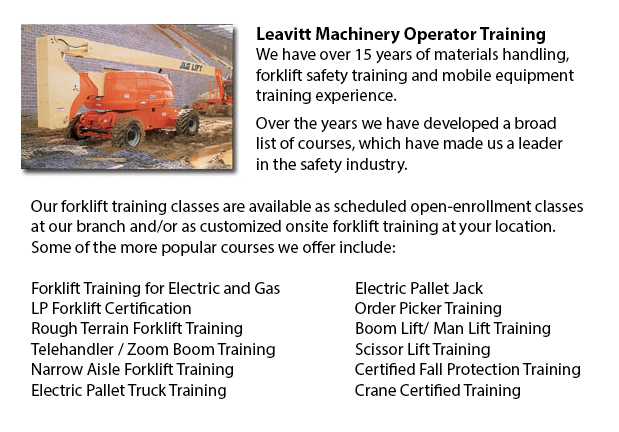
Boom Lift Certification Richmond Hill - Elevated work platforms allow maintenance operations and work to be done at levels that could not be reached by any other method. Workers utilizing boom lifts and scissor lifts could be taught how to safely operate these equipments by getting boom lift certification training.
Despite the range in lift style, applications and site conditions, all lifts have the potential for serious injury or death when not safely operated. Electrocution, falls, crushed body parts, and tip-overs could be the tragic outcome of wrong operating procedures.
To be able to avoid aerial lift incidents, boom lift operators have to be trained by qualified workers in the safe operation of the particular kind of aerial lift they would be using. Aerial lifts must never be altered without the express permission of the manufacturer or other recognized entity. If you are leasing a lift, ensure that it is maintained correctly. Before utilizing, controls and safety devices must be checked to make certain they are functioning correctly.
It is vital to follow safe operating procedures to be able to avoid workplace incidents. Driving an aerial lift while the lift is extended should not be carried out, nevertheless, a few models are designed to be driven when the lift is extended. Set outriggers, if available. Always set brakes. Avoid slopes, but when necessary make use of wheel chocks on slopes which do not go over the manufacturer's slope restrictions. Adhere to manufacturer's load and weight limitations. When standing on the boom lift's platform, utilize full-body harnesses or a safety belt with a two-foot lanyard tied to the basket or boom. Fall protection is not needed for scissor lifts which have guardrails. Do not sit or climb on guardrails.
The boom lift certification course provides instruction in the following fields: safety tips in order to prevent a tip-over; training and certification; inspecting the travel path and work area; slopes and surface conditions; other tips for maintaining stability; stability factors; leverage; weight capacity; pre-operational inspection; testing control functions; safe operating practices; mounting a vehicle; power lines and overhead obstacles; safe driving procedures; use of lanyards and harness; PPE and fall protection; and prevent falling from the platform.
The successful trainee would learn the following: training and authorization procedures; pre-operational check procedures; factors affecting the stability of boom and scissor lifts; how to prevent tip-overs; how to use PPE, how to use the testing control functions and strategies in order to avoid falls.
-
Scissor Lift Certification Richmond Hill
Scissor Lift Certification Richmond Hill - Scissor lift platforms are utilized at work sites in order to allow tradespeople - like for example welders, masons and iron workers - to reach their work. Operating a scissor lift platform is usually second... More -
Narrow Aisle Forklift / Order Picker Training / Electric Pallet Jack / Electric Pallet Truck Training in Richmond Hill
A pallet jack is a model of equipment specialized in the transporting of pallets of many dimensions and weights. They might be utilized as an appendage for lift trucks, cranes and other types of heavy machinery or be used on their own. Pallet jacks a... More -
Heavy Equipment Operator Certification Richmond Hill
Heavy Equipment Operator Certification Richmond Hill - The heavy equipment operator is a person who manipulates the controls and drives various kinds of big machinery. Heavy machinery is most frequently used on construction sites in order to deliver... More -
Loader Training Richmond Hill
Loader Training Richmond Hill - Why You Must Finish A Loader Training Course - Individuals wanting work in businesses that use lift trucks must undergo a Loader Training program prior to becoming a certified operator of a lift truck. There are lots o... More -
Manlift Training Richmond Hill
Manlift Training Richmond Hill - Various manlift training programs consist of the review and content of manlift devices. An important part of the course is the practicum where students show their knowledge and practical ability to safely operate a ma... More -
Fall Protection Training in Richmond Hill
There are many injuries at work associated to falling and a lot of fall-related deaths reported every year. Most of these instances could have been prevented with better training, better measures in place, and by correctly equipping personnel before... More -
Wheel Loader Training Richmond Hill
Wheel Loader Training Richmond Hill - Commonly, the various kinds of heavy equipment training are classed into 2 categories of machinery: those which have rubber tires and tracked vehicles. Tracked vehicles consist of items like cranes, bulldozers an... More -
Forklift Certification Schools Richmond Hill
Forklift Certification Schools Richmond Hill - Forklift Certification is mandatory in North America. Hence, forklift training programs are important both for companies and for people seeking jobs in industries as forklift operators. Forklift training... More

Forklift Training Richmond Hill
TOLL FREE: 1-888-254-6157
Richmond Hill, Ontario
forklifttrainingrichmondhill.com
Email Us
About Us


